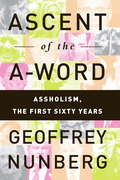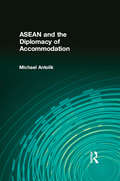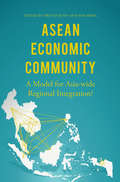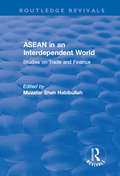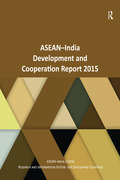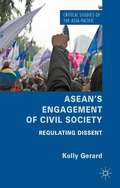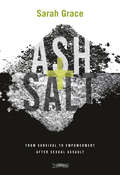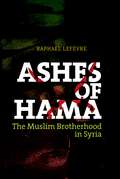- Table View
- List View
The Ascent of Mary Somerville in 19th Century Society (Springer Biographies)
by Elisabetta StricklandThis biography traces the life and work of Mary Fairfax Somerville, whose extraordinary mathematical talent only came to light through fortuitous circumstances. Barely taught to read and write as a child, all the science she learned and mastered was self taught. In this delightful narrative the author takes up the challenge of discovering how Somerville came to be one of the most outstanding British women scientists and, furthermore, a popular writer. Particular attention is paid to the gender aspects of Somerville's success in what was, to put it mildly, a predominantly male domain.
The Ascent of Media: From Gilgamesh to Google via Gutenburg
by Roger ParryOur society is shaped by our media – now more than at any time in history. They play a crucial role in culture, commerce and politics alike. The Ascent of Media is the first book to look at the new digital era in the context of all that has gone before, and to build on the past to describe the media landscape of the future. Roger Parry takes us on a journey from the earliest written story – the Legend of Gilgamesh etched on clay tablets – to the Gutenberg press, and from the theatres of Athens to satellite TV and the coming semantic web. Tracing 3000 years of history, he shows how today’s media have been shaped by the interaction of politics, economics and technology. He explains why Britain has the public service BBC whilst America developed the private broadcasting networks ABC, CBS, FOX and NBC. He profiles the people and organizations that have created the media world and reveals the often surprising stories behind such ubiquitous items as the keyboard, telephone dial and tabloid. The book shows that issues of today such as a sensationalist press, piracy, monopoly, walled gardens and balancing advertising and subscription revenue have all happened before. Each upheaval in the media world – the development of moveable type printing in the 1450s; the telegraph network in the 1850s; radio broadcasting in the 1920s; and digital distribution in the 2000s – created huge fortunes, challenged authority and raised fundamental issues of copyright, privacy and censorship. Traditional media then adapt, evolve and go on to thrive in the face of competition. The convergence of the internet, mobile phones and tablet computers is now transforming our culture. Established media giants are struggling, while new firms like Google and Apple are thriving. The superabundance of media, with increasing amounts generated by consumers themselves, means that media professionals are becoming curators as much as creators of content. The Ascent of Media traces the story of media from clay tablets to tabloids to the tablet computer. It relates how we got where we are and, based on the experience of history, where we are likely to go next.
Ascent of the A-Word: Assholism, the First Sixty Years
by Geoffrey NunbergIt first surfaced in the gripes of GIs during World War II and was captured early on by the typewriter of a young Norman Mailer. Within a generation it had become a basic notion of our everyday moral life, replacing older reproaches like lout and heel with a single inclusive category––a staple of country outlaw songs, Neil Simon plays, and Woody Allen movies. Feminists made it their stock rebuke for male insensitivity, the est movement used it for those who didn&’t &“get it,&” and Dirty Harry applied it evenhandedly to both his officious superiors and the punks he manhandled. The asshole has become a focus of collective fascination for us, just as the phony was for Holden Caulfield and the cad was for Anthony Trollope. From Donald Trump to Ann Coulter, from Mel Gibson to Anthony Weiner, from the reality TV prima donnas to the internet trolls and flamers, assholism has become the characteristic form of modern incivility, which implicitly expresses our deepest values about class, relationships, authenticity, and fairness. We have conflicting attitudes about the A-word––when a presidential candidate unwittingly uttered it on a live mic in 2000, it confirmed to some that he was a man of the people and to others that he was a boor. But considering how much the word does for us, and to us, it hasn&’t gotten nearly the attention it deserves––at least until now.
Ascent of the A-Word: Assholism, the First Sixty Years
by Geoffrey NunbergIt first surfaced in the gripes of GIs during World War II and was captured early on by the typewriter of a young Norman Mailer. Within a generation it had become a basic notion of our everyday moral life, replacing older reproaches like lout and heel with a single inclusive category -- a staple of country outlaw songs, Neil Simon plays, and Woody Allen movies. Feminists made it their stock rebuke for male insensitivity, the est movement used it for those who didn't "get it," and Dirty Harry applied it evenhandedly to both his officious superiors and the punks he manhandled. The asshole has become a focus of collective fascination for us, just as the phony was for Holden Caulfield and the cad was for Anthony Trollope. From Donald Trump to Ann Coulter, from Mel Gibson to Anthony Weiner, from the reality TV prima donnas to the internet trolls and flamers, assholism has become the characteristic form of modern incivility, which implicitly expresses our deepest values about class, relationships, authenticity, and fairness. We have conflicting attitudes about the A-word -- when a presidential candidate unwittingly uttered it on a live mic in 2000, it confirmed to some that he was a man of the people and to others that he was a boor. But considering how much the word does for us, and to us, it hasn't gotten nearly the attention it deserves -- at least until now.
Ascetic Practices in Japanese Religion (Japan Anthropology Workshop Series)
by Tullio Federico LobettiAscetic practices are a common feature of religion in Japan, practiced by different religious traditions. This book looks at these ascetic practices in an inter-sectarian and inter-doctrinal fashion, in order to highlight the underlying themes common to all forms of asceticism. It does so by employing a multidisciplinary methodology, which integrates participant fieldwork – the author himself engaged extensively in ascetic practices – with a hermeneutical interpretation of the body as the primary locus of transmission of the ascetic ‘embodied tradition’. By unlocking this ‘bodily data’, the book unveils the human body as the main tool and text of ascetic practice. This book includes discussion of the many extraordinary rituals practiced by Japanese ascetics.
Ascetic Practices in Japanese Religion (Japan Anthropology Workshop Series)
by Tullio Federico LobettiAscetic practices are a common feature of religion in Japan, practiced by different religious traditions. This book looks at these ascetic practices in an inter-sectarian and inter-doctrinal fashion, in order to highlight the underlying themes common to all forms of asceticism. It does so by employing a multidisciplinary methodology, which integrates participant fieldwork – the author himself engaged extensively in ascetic practices – with a hermeneutical interpretation of the body as the primary locus of transmission of the ascetic ‘embodied tradition’. By unlocking this ‘bodily data’, the book unveils the human body as the main tool and text of ascetic practice. This book includes discussion of the many extraordinary rituals practiced by Japanese ascetics.
ASEAN and India–ASEAN Relations: Navigating Shifting Geopolitics (Routledge Studies on Think Asia)
by M. MayilvagananThis book analyses the nearly 30 years of India–ASEAN relations from a contemporary perspective, identifies the reasons for India’s vibrant and significant relation with ASEAN and examines the cultural, economic, political and strategic linkages between India and ASEAN. The book projects the future of India–ASEAN relations in the face of the changing Indo-Pacific geopolitics and explores potential policies which could enhance the connection between India and Southeast Asian countries. Arguing that ASEAN is of primary importance to India, the book suggests that any successful outing in the Indo-Pacific would need a strong partnership with India. The book demonstrates how external powers influence ASEAN, with many of them supporting the centrality of ASEAN and its regional architecture in the broader Indo-Pacific. Chapters by experts in their fields present thematically specific analyses of political, defence, maritime and cultural aspects as well as the position of Northeast India in the India–ASEAN relations and assess the success and challenges of India’s ties with ASEAN in the context of the Look East and the Act East Policies. A reassessment of ASEAN–India relations past and present, this book will be of interest to academics and policy makers working in the field of International Relations, Asian Politics and South Asian Politics, in particular India’s Foreign Policy and Southeast Asian Politics.
ASEAN and India–ASEAN Relations: Navigating Shifting Geopolitics (Routledge Studies on Think Asia)
by M. MayilvagananThis book analyses the nearly 30 years of India–ASEAN relations from a contemporary perspective, identifies the reasons for India’s vibrant and significant relation with ASEAN and examines the cultural, economic, political and strategic linkages between India and ASEAN. The book projects the future of India–ASEAN relations in the face of the changing Indo-Pacific geopolitics and explores potential policies which could enhance the connection between India and Southeast Asian countries. Arguing that ASEAN is of primary importance to India, the book suggests that any successful outing in the Indo-Pacific would need a strong partnership with India. The book demonstrates how external powers influence ASEAN, with many of them supporting the centrality of ASEAN and its regional architecture in the broader Indo-Pacific. Chapters by experts in their fields present thematically specific analyses of political, defence, maritime and cultural aspects as well as the position of Northeast India in the India–ASEAN relations and assess the success and challenges of India’s ties with ASEAN in the context of the Look East and the Act East Policies. A reassessment of ASEAN–India relations past and present, this book will be of interest to academics and policy makers working in the field of International Relations, Asian Politics and South Asian Politics, in particular India’s Foreign Policy and Southeast Asian Politics.
ASEAN and the Diplomacy of Accommodation
by Michael AntolikThis book studies the activities undertaken by the ASEAN states and reflects the inspiration and support of many individuals. The ASEAN phenomenon is about the successful consultative process, the accommodation, that these states used in managing tensions and dealing with external environments.
ASEAN and the Diplomacy of Accommodation
by Michael AntolikThis book studies the activities undertaken by the ASEAN states and reflects the inspiration and support of many individuals. The ASEAN phenomenon is about the successful consultative process, the accommodation, that these states used in managing tensions and dealing with external environments.
ASEAN Economic Community: A Model for Asia-wide Regional Integration?
by Bruno Jetin Mia MikicThe launch of the ASEAN Economic Community raises key issues: the deepening of regional trade and the associated problem of exchange rate management. This volume questions the capacity of a shallow institution to deal with complex impacts on employment and inequality. Contributors analyze ASEAN's potential and weakness in readable terms.
ASEAN in an Interdependent World: Studies in an Interdependent World (Routledge Revivals)
by Muzafar Shah HabibullahThis title was first published in 2000. This volume contains nine selected applied economic papers presented during the 1999 Faculty of Economics and Management Seminar in Melaka. The articles included focus the studies on trade and finance in Malaysia and other ASEAN member countries.
ASEAN in an Interdependent World: Studies in an Interdependent World (Routledge Revivals)
by Muzafar Shah HabibullahThis title was first published in 2000. This volume contains nine selected applied economic papers presented during the 1999 Faculty of Economics and Management Seminar in Melaka. The articles included focus the studies on trade and finance in Malaysia and other ASEAN member countries.
ASEAN-India Development and Cooperation Report 2015
by Asean�India CentreIndia‘s engagement with the Association of Southeast Asian Nations (ASEAN) is at the heart of its Look East Policy. As a regional bloc, ASEAN has developed much faster than any of the other blocs in the Asia-Pacific. With ASEAN and India working towards establishing a Comprehensive Free Trade Area through Regional Comprehensive Economic Partnership Agreement (RCEP), their cooperation will be key to promoting economic stability, competitiveness, growth and integration in the region. This Report: provides a comparative analysis of the global and regional economies; examines the impact and implications of India ASEAN integration; assesses policy priorities, effectiveness, implementation imperatives and challenges; and discusses themes central to the economic sustainability of the region, including public and foreign policy, trade facilitation, financial and scientific cooperation, food security, energy cooperation, and productivity and opportunities in the manufacturing and service sectors. It will be invaluable to scholars and researchers of economics, international relations, development studies, area studies, as well as policy-makers, administrators, private sector professionals, and non-governmental organisations in the field.
ASEAN-India Development and Cooperation Report 2015
by Asean�India CentreIndia‘s engagement with the Association of Southeast Asian Nations (ASEAN) is at the heart of its Look East Policy. As a regional bloc, ASEAN has developed much faster than any of the other blocs in the Asia-Pacific. With ASEAN and India working towards establishing a Comprehensive Free Trade Area through Regional Comprehensive Economic Partnership Agreement (RCEP), their cooperation will be key to promoting economic stability, competitiveness, growth and integration in the region. This Report: provides a comparative analysis of the global and regional economies; examines the impact and implications of India ASEAN integration; assesses policy priorities, effectiveness, implementation imperatives and challenges; and discusses themes central to the economic sustainability of the region, including public and foreign policy, trade facilitation, financial and scientific cooperation, food security, energy cooperation, and productivity and opportunities in the manufacturing and service sectors. It will be invaluable to scholars and researchers of economics, international relations, development studies, area studies, as well as policy-makers, administrators, private sector professionals, and non-governmental organisations in the field.
ASEAN, Sovereignty and Intervention in Southeast Asia (Critical Studies of the Asia-Pacific)
by L. JonesDrawing on the fields of political economy and historical sociology, Jones dispels the overwhelming consensus among scholars that members of the Association of Southeast Asian Nations (ASEAN) never interfere in the internal affairs of other states, and pioneers a new approach to the understanding of regional politics in Southeast Asia.
ASEAN’s Cooperative Security Enterprise: Norms and Interests in the ASEAN Regional Forum (Critical Studies of the Asia-Pacific)
by H. KatsumataKatsumata demonstrates that something interesting is taking place inside the ASEAN Regional Forum (ARF). He shows that an association of minor powers in Southeast Asia is promoting its cooperative security norm, and influencing the policies of its external partners. Thus, the ARF is one of the important pathways to regional security.
ASEAN's Engagement of Civil Society: Regulating Dissent (Critical Studies of the Asia-Pacific)
by Kelly GerardThis book offers an innovative framework for understanding the role of civil society in regional and global policymaking. Using political economy analysis, Gerard demonstrates that ASEAN's people-oriented agenda builds legitimacy, while sidelining its detractors.
Asexualities: Feminist and Queer Perspectives (Routledge Research in Gender and Society)
by Karli June Cerankowski Megan MilksWhat is so radical about not having sex? To answer this question, this collection of essays explores the feminist and queer politics of asexuality. Asexuality is predominantly understood as an orientation describing people who do not experience sexual attraction. In this multidisciplinary volume, the authors expand this definition of asexuality to account for the complexities of gender, race, disability, and medical discourse. Together, these essays challenge the ways in which we imagine gender and sexuality in relation to desire and sexual practice. Asexualities provides a critical reevaluation of even the most radical queer theorizations of sexuality. Going beyond a call for acceptance of asexuality as a legitimate and valid sexual orientation, the authors offer a critical examination of many of the most fundamental ways in which we categorize and index sexualities, desires, bodies, and practices. As the first book-length collection of critical essays ever produced on the topic of asexuality, this book serves as a foundational text in a growing field of study. It also aims to reshape the directions of feminist and queer studies, and to radically alter popular conceptions of sex and desire. Including units addressing theories of asexual orientation; the politics of asexuality; asexuality in media culture; masculinity and asexuality; health, disability, and medicalization; and asexual literary theory, Asexualities will be of interest to scholars and students in sexuality, gender, sociology, cultural studies, disability studies, and media culture.
Asexualities: Feminist and Queer Perspectives (Routledge Research in Gender and Society #40)
by Karli June Cerankowski Megan MilksWhat is so radical about not having sex? To answer this question, this collection of essays explores the feminist and queer politics of asexuality. Asexuality is predominantly understood as an orientation describing people who do not experience sexual attraction. In this multidisciplinary volume, the authors expand this definition of asexuality to account for the complexities of gender, race, disability, and medical discourse. Together, these essays challenge the ways in which we imagine gender and sexuality in relation to desire and sexual practice. Asexualities provides a critical reevaluation of even the most radical queer theorizations of sexuality. Going beyond a call for acceptance of asexuality as a legitimate and valid sexual orientation, the authors offer a critical examination of many of the most fundamental ways in which we categorize and index sexualities, desires, bodies, and practices. As the first book-length collection of critical essays ever produced on the topic of asexuality, this book serves as a foundational text in a growing field of study. It also aims to reshape the directions of feminist and queer studies, and to radically alter popular conceptions of sex and desire. Including units addressing theories of asexual orientation; the politics of asexuality; asexuality in media culture; masculinity and asexuality; health, disability, and medicalization; and asexual literary theory, Asexualities will be of interest to scholars and students in sexuality, gender, sociology, cultural studies, disability studies, and media culture.
Asexualities: Feminist and Queer Perspectives, Revised and Expanded Ten-Year Anniversary Edition (Routledge Research in Gender and Society)
by Megan Milks Kj CerankowskiAs one of the first book-length collections of critical essays on the topic of asexuality, Asexualities: Feminist and Queer Perspectives became a foundational text in the burgeoning field of asexuality studies. This revised and expanded ten-year anniversary edition both celebrates the book’s impact and features new scholarship at the vanguard of the field.While this edition includes some of the most-cited original chapters, it also features critical updates as well as new, innovative work by both up-and-coming and established scholars and activists from around the world. It brings in more global perspectives on asexualities, engages intersectionally with international formations of race and racialization, critiques global capital’s effects on identity and kinship, examines how digital worlds shape lived realities, considers posthuman becomings, experiments with the form of the manifesto, and imagines love and relation in ecologies that exceed and even supersede the human.This cutting-edge, multidisciplinary, interdisciplinary book serves as a valuable resource for everyone—from those who are just beginning their critical exploration of asexualities to advanced researchers who seek to deepen their theoretical engagements with the field.
Asexualities: Feminist and Queer Perspectives, Revised and Expanded Ten-Year Anniversary Edition (Routledge Research in Gender and Society)
As one of the first book-length collections of critical essays on the topic of asexuality, Asexualities: Feminist and Queer Perspectives became a foundational text in the burgeoning field of asexuality studies. This revised and expanded ten-year anniversary edition both celebrates the book’s impact and features new scholarship at the vanguard of the field.While this edition includes some of the most-cited original chapters, it also features critical updates as well as new, innovative work by both up-and-coming and established scholars and activists from around the world. It brings in more global perspectives on asexualities, engages intersectionally with international formations of race and racialization, critiques global capital’s effects on identity and kinship, examines how digital worlds shape lived realities, considers posthuman becomings, experiments with the form of the manifesto, and imagines love and relation in ecologies that exceed and even supersede the human.This cutting-edge, multidisciplinary, interdisciplinary book serves as a valuable resource for everyone—from those who are just beginning their critical exploration of asexualities to advanced researchers who seek to deepen their theoretical engagements with the field.
Ash + Salt: From Survival to Empowerment after Sexual Assault
by Sarah GraceSarah Grace is a sexual assault survivor. On 17 July 2019, she fell asleep like any other night. A burglar broke into her apartment and attacked her as she slept. What followed was a fight for her life. That violent assault blew apart her world, reducing everything in it to ashes. From that battle, Sarah has waged many more. She had to fight her way through post-traumatic stress, the social stigma around sexual assault and an archaic court system in her bid to ensure her attacker couldn’t do the same to another woman. Some adversities were predictable – nightmares, panic attacks and the devastating loss of self. Others were surprising – toxic social reactions, friends withdrawing and a nightmarish trial that unearthed how heavily the criminal justice system is loaded against victims. Ash + Salt is a raw and powerful account of healing and thriving after sexual assault. Armed with courage and brazen candour, Sarah takes you through her own story to reveal the experience of a survivor. She offers the tools to survive the assault, its aftermath and the trial, and charts the path back to recovery. Because while ash marks the place of devastation, it is also the fertile soil from which new life can grow. This is a book for everyone – not just survivors, but their families, friends and colleagues too. Sexual assault affects us all, regardless of background or gender. It is one woman’s personal testimony, but it is also a call to arms. The time to speak up is now.
Ashes of Hama: The Muslim Brotherhood in Syria
by Raphael LefevreWhen the convulsions of the Arab Spring first became manifest in Syria in March 2011, the Ba'athist regime was quick to blame the protests on the "Syrian Muslim Brotherhood" and its "al-Qaeda affiliates." But who are these Islamists so determined to rule a post-Assad Syria? Little has been published on militant Islam in Syria since Hafez Assad's regime destroyed the Islamist movement in its stronghold of Hama in February 1982. This book bridges that gap by providing readers with the first comprehensive account of the Syrian Muslim Brotherhood's history to date. In this ground-breaking account of Syria's most prominent, yet highly secretive, Islamist organisation, the author draws on previously untapped sources: the memoirs of former Syrian jihadists; British and American archives; and also a series of wide-ranging interviews with the Syrian Muslim Brotherhood's historical leaders as well as those who battled against them--many speaking on the record for the first time. Ashes of Hama uncovers the major aspects of the Islamist struggle: from the Brotherhood's radicalisation and its "jihad" against the Ba'athist regime and subsequent exile, to a spectacular comeback at the forefront of the Syrian revolution in 2011--a remarkable turnaround for an Islamist movement which all analysts had pronounced dead amid the ruins of Hama in 1982.
Ashes of Hama: The Muslim Brotherhood in Syria
by Raphael LefevreWhen the convulsions of the Arab Spring first became manifest in Syria in March 2011, the Ba'athist regime was quick to blame the protests on the "Syrian Muslim Brotherhood" and its "al-Qaeda affiliates." But who are these Islamists so determined to rule a post-Assad Syria? Little has been published on militant Islam in Syria since Hafez Assad's regime destroyed the Islamist movement in its stronghold of Hama in February 1982. This book bridges that gap by providing readers with the first comprehensive account of the Syrian Muslim Brotherhood's history to date. In this ground-breaking account of Syria's most prominent, yet highly secretive, Islamist organisation, the author draws on previously untapped sources: the memoirs of former Syrian jihadists; British and American archives; and also a series of wide-ranging interviews with the Syrian Muslim Brotherhood's historical leaders as well as those who battled against them--many speaking on the record for the first time. Ashes of Hama uncovers the major aspects of the Islamist struggle: from the Brotherhood's radicalisation and its "jihad" against the Ba'athist regime and subsequent exile, to a spectacular comeback at the forefront of the Syrian revolution in 2011--a remarkable turnaround for an Islamist movement which all analysts had pronounced dead amid the ruins of Hama in 1982.


